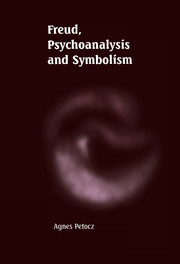Book contents
- Frontmatter
- Contents
- List of figures
- Preface
- Introduction
- Part One Exegesis and Extraction
- 1 From disorder towards the focus of inquiry
- 2 The ‘Freudian Narrow’ (FN) theory of symbolism
- 3 The ‘symbol’ in Freud's early writings (1893–1899)
- 4 Continuation and elaboration (1900–1913)
- 5 The ‘core years’ for the FN theory (1914–1917)
- 6 The treatment of symbolism in Freud's later writings (1918–1940)
- Part Two Consolidation and Defence
- Epilogue
- List of references
- Index
5 - The ‘core years’ for the FN theory (1914–1917)
Published online by Cambridge University Press: 22 October 2009
- Frontmatter
- Contents
- List of figures
- Preface
- Introduction
- Part One Exegesis and Extraction
- 1 From disorder towards the focus of inquiry
- 2 The ‘Freudian Narrow’ (FN) theory of symbolism
- 3 The ‘symbol’ in Freud's early writings (1893–1899)
- 4 Continuation and elaboration (1900–1913)
- 5 The ‘core years’ for the FN theory (1914–1917)
- 6 The treatment of symbolism in Freud's later writings (1918–1940)
- Part Two Consolidation and Defence
- Epilogue
- List of references
- Index
Summary
The FN theory, according to which symbols are distinguished from all other material by the three characteristics of constant meaning, ‘muteness’, and phylogenetic inheritance, is typically regarded both by supporters and by critics of psychoanalysis as the Freudian theory of symbolism. In Chapter 2, I presented that theory in detail by extracting from Freud's writings all of his explicit statements of the FN view. Noticeably, most of those statements are in material published during the period 1914 to 1917 (in particular, the fourth edition of The Interpretation of Dreams, and the tenth lecture in the Introductory Lectures on Psycho-Analysis). Accordingly, this period may be identified as the ‘core’ years for the FN theory. In Chapters 3 and 4, I documented certain significant features of the Freudian material on symbolism leading up to these core years. Freud's earliest writings contain the basis for a much broader (FB) theory of symbolism, consisting of a general conceptual schema and a number of important unifying themes. Subsequent writings show much continuity with the earlier work, and, while a slow convergence onto the FN view is discernible, this is relatively weak compared with the FB themes which emerge from the rest of Freud's material, and which are progressively elaborated and consolidated. However, Freud himself did not organise his material explicitly according to the FB schema and its themes, and he did not appear to recognise the value of much of that material.
- Type
- Chapter
- Information
- Freud, Psychoanalysis and Symbolism , pp. 98 - 124Publisher: Cambridge University PressPrint publication year: 1999



